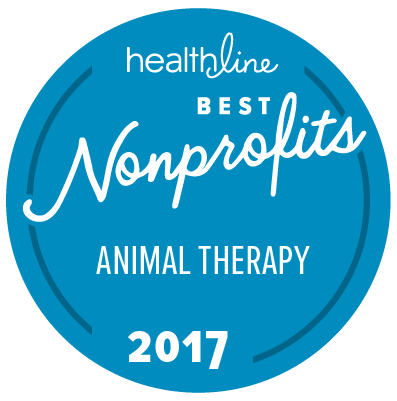Healthy aging is a lifelong process of making healthy decisions and lifestyle choices. Ensuring physical health at every stage of life helps us live longer and reduces risk of illness, disability and death. A significant body of literature has demonstrated the positive relationship between pet ownership and physical health, including increased physical activity and cardiovascular health.
Physical Health

While simply walking your dog can provide health benefits, groups like K9 Fit Club (pictured) incorporate companion animals into more rigorous workouts for improved motivation. Photo: K9 Fit Club
Physical Activity
Recreational walking is a form of casual exercise that confers many health benefits. One study examining new dog owners found that new acquisition of a dog leads to an increase in walking, concluding dog ownership can cause new owners to view the activity of walking more favorably.[1] In addition, research demonstrates that dog owners engage in more physical activity and walking and are more likely to achieve the recommended physical activity than non-owners.
- On average, dog owners walk more minutes per week than non-owners
- A study that analyzed data from a 2005 Michigan Behavioral Risk Factor Survey found that dog walking was associated with a significant increase in walking activity and leisure-time physical activity, and concluded that the promotion of dog walking could help increase leisure-time physical activity (LTPA). The study findings include:
- Dog walkers walked about an hour more per week than dog owners who did not walk their dog, and about a half an hour more per week than non-dog owners
- Approximately 60% of dog walkers met the criteria for regular moderate and/or vigorous LTPA compared with about 45% for non-dog owners and dog owners who did not walk their dog
- Compared with non-dog owners, the odds of obtaining at least 150 minutes per week of total walking were 34% higher for dog walkers and the odds of doing any LTPA were 69% higher[2]
- A study comparing pregnant women who owned dogs to pregnant women who were non-owners concluded dog ownership was associated with an increased likelihood of undertaking at least 3 hours per week of physical activity.[3]
- A study that analyzed data from a 2005 Michigan Behavioral Risk Factor Survey found that dog walking was associated with a significant increase in walking activity and leisure-time physical activity, and concluded that the promotion of dog walking could help increase leisure-time physical activity (LTPA). The study findings include:
- Many studies have explored the relationship between pet ownership and cardiovascular health through focusing on the blood pressure, heart rate and physical activity of pet owners compared to non-pet owners. The American Heart Association (AHA) reviewed these studies and issued a Scientific Statement connecting pet ownership to the prevention of cardiovascular disease.[4]
- Of all pets, dogs appear most likely to positively influence the level of human physical activity.
- Dog owners engage in significantly more minutes per week of physical activity and walking and were 54% more likely to meet the recommended level of physical activity than non-owners, according to a cross-sectional study of over 5,000 adult dog owners.
- According to the AHA’s Scientific Statement, results demonstrating dog owners engage in more minutes per week of walking are consistent when controlled for sociodemographic, neighborhood, social environmental, and intrapersonal factors.
- Dog walking has been found to provide unique health benefits for older adults.
- One study examining a community of older adults concluded that dog ownership leads to increased physical activity.
- Additionally, the researchers concluded dog ownership increased connectedness to the community. Older adults who did not own dogs were still able to benefit from increased physical activity through participating in community pet-care.[5]
- A study of a national cohort of over 11,000 adults over 40 across 8.5 years found those living with a dog were most likely to be in the highest activity group and least likely to be in the no-activity group.[6]
Obesity
- Research demonstrates that dog walking may be associated with a lower incidence of obesity
- According to a Scientific Statement released by the American Heart Association, pets act as social support, which is one of the most powerful predictors of adoption and maintenance of behavior change, including weight loss.
- Individuals who do not own a dog had a nearly 2-fold greater odds of being overweight, while those who did not walk their dog had 60% higher odds of being overweight compared with dog walkers.[7]
Cardiovascular Health
Reducing Risk of Heart-Related Health Issues
Several studies have demonstrated an association between pet ownership and a lower risk of cardiovascular diseases and heart-related health issues.
-
- A study of over 2,400 cat owners concluded there was a significantly lower relative risk for death due to cardiovascular diseases, including stroke and heart attack, compared to non-owners during a 20 year follow-up.[8]
- A study assessing the relationship between pet owners and coronary artery disease (CAD) in a Chinese population concluded pet ownership has a protective effect on CAD patients. Dog-owning participants had a significantly lower risk for CAD.
- The length of pet ownership was also indicative of improved heart health. Specifically, the researchers found a decreased tendency of CAD among those who owned a pet for longer. A similar decreased tendency of CAD was also observed in individuals who spent more time playing with their pet.[9]
- In a study of adults over the age of 50 with mildly elevated blood pressure, the presence of a pet dog or cat had a significant impact on blood pressure, with dog ownership being associated with lower diastolic and systolic blood pressure compared to people who did not own pets.[10]
-
The researchers from this study conclude that pets, especially dogs, may be effective as an adjunctive intervention to reduce blood pressure and/or cardiac responses to stressors during their owners’ daily lives, and thus may slow the development or progression of hypertension in older adults who live with pets.
-
- In a cross-sectional online survey, non-dog-owners were more likely to report elevated serum cholesterol levels and diabetes than dog owners who regularly walked their dogs.[11]
Improving Cardiovascular Recovery and Disease Management
A growing body of literature indicates that long periods of recovery following exposure to stress can act as a risk factor for health problems such as high blood pressure. Research shows that pets can buffer reactivity to acute stress as well as diminish perceptions of stress.
-
- Specifically, one study tested stress reactivity in 120 married couples, comparing results for pet-owners and non-owners.
- Relative to non-owners, people with pets had significantly lower resting heart rate, systolic blood pressure, diastolic blood pressure; exhibited significantly lower HR, SBP and DBP reactivity during a mental arithmetic task, and returned to baseline levels faster.[12]
- To learn more about how pet ownership attenuates stress in older adults, see Healthy Aging and Mental Health.
- Specifically, one study tested stress reactivity in 120 married couples, comparing results for pet-owners and non-owners.
- In a study of individuals with one or more cardiac risk factors, pet ownership was associated with greater adaptability to disturbances in the cardiovascular system.[13]
- Reduced heart rate variability (HRV) is associated with cardiac disease and mortality. A study of 102 patients who suffered a heart attack, dog and/or cat owners had significantly higher heart rate variability than nonowners.
- Several studies have demonstrated similar beneficial effects on cardiovascular stress responses among goat,[14] fish,[15] and snake[16] owners.
HABRI-Funded Studies
HABRI is currently funding two studies that are examining interventions based on increasing dog-walking in communities.









